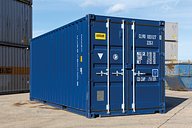How do you join shipping containers together and what are the benefits of connecting them? We're going to briefly explain the most common ways our containers are merged, and demonstrate these methods with a few examples of our very own container modifications.

ISO standards mean that the majority of shipping containers are 8 foot wide, which can often be quite limiting for those wanting to do more with their unit than store goods. Shipping container conversions have boomed in recent history, with offices, classrooms, restaurants, and even entire food and entertainment villages being created as a more space-efficient, cost-effective option.
Here at Cleveland Containers we provide a first-class modification service, co-operating with our customers and their specific needs and requirements to make their ideal product or workspace a reality. Many of these projects involve using multiple containers to create a more convenient, larger, or open plan space.
What Are the Benefits of Joining Two or More Containers Together?
Using modified shipping containers means you can create a bespoke build that suits your exact requirements. They can be more cost effective than purchasing or building a bricks and mortar structure that still might not tick all the necessary boxes, and also, depending on the way that they are made they could be easily dismantled in order to be relocated.
How Are Containers Connected to Make One Unit?
There are several ways that containers can be joined, and the chosen method depends on several factors. For example, whether the desired structure is planned to be permanent or not.
A permanent structure is most likely to be fully welded, this being the best option for large openings such as an entire wall of a 20ft or 40ft container. This weld would continue around the entire perimeter of the container with the ends being welded together to prevent any water ingress at the corner posts, making the unit fully watertight.

When removing the wall, a slice of the panel under the top rail is left in place to prevent the roof sagging and a small reinforcement beam is then installed. The more of the panel that remains, the more support it will provide.
When removing the wall, a slice of the panel under the top rail is left in place to prevent the roof sagging and a small reinforcement beam is then installed. The more of the panel that remains, the more support it will provide.

Welding is the most common way containers are joined for permanent, semi-permanent and larger projects such as STACK Newcastle. This makes for a stronger, totally watertight structure however it requires more on-site work and tends to be a slower, more expensive process.
If the containers require entry through a single or double door only, or need to be portable, then the most useful option is to join them just at this point by using sleeves. This is a quick solution that requires very little on-site work.

C-channel sleeves are installed around door frames to make this part of the join watertight. The space required between the containers to install the sleeves allows water to drain naturally between them.

This simple, cost effective design does not mechanically fix the containers together but it has the benefit of being removable, meaning the unit can be taken apart and re-sited if needed.
Another method we have previously applied involves bolting containers together and installing flashings, a weatherproofing material that prevents water from entering the structure.

A container ready to be bolted to another unit. Here, you can see the tongue and groove flooring system which connects to the second container, and also the two temporary posts used to support the structure during transportation.
What Actions Need to be Taken to Make Sure the Joined Containers are Safe and Sound?
Joined containers require reinforcement at various points for them to remain structurally sound. These points are typically around the ceiling, floor and opening areas but are specific to each build. We can scale reinforcements to suit varying needs including fitting doors and windows.
When it comes to the container floors, we have a locking system that locks them together to reduce any independent movement and provide a more stable platform to overlay floor coverings.
Temporary posts can be installed to prevent the containers moving or becoming damaged during transportation. When being placed, a level foundation is crucial to ensure the entire structure sits at the same height and is properly aligned. For heavy duty applications, it may be advised to install base plates that bolt the container to the ground to prevent any movement whatsoever.
Can Container Conversions Have Plumbing and Electricals Installed?
Yes, containers are able to have plumbing and electrics installed to make them a fully functioning work or living space. These elements are mostly carried out on-site and how much of this we do depends on how involved we are with the final stages of the conversion. We are able to do the entire works, however for many projects we will only install the provisions to run any cabling or electricity if the client has requested to organise the finishing touches themselves. To complete a container conversion, finishes such as plaster and drywall can be added to remove any remaining aspects of a shipping container interior.
Do You Have Any Examples of Connected Container Conversions?
Yes, we have worked on a number of container conversions that have involved multiple units. Take a look at just a few of our case studies below:
Stack Newcastle: This leisure and retail development consisting of 60 shipping containers is home to a number of bars, pop up shops, cafés, and restaurants.
Stack Seaburn: Following the success of STACK Newcastle, STACK Seaburn later opened in the seaside town just 3 miles from Sunderland City Centre featuring multiple bars, restaurants, a dog groomers, a games area, and a stage for live performances.
Northern School of Art: The Art and Design school based in Hartlepool contacted Cleveland Containers to design and create two class rooms made from a 40ft high cube and a 20ft high cube container.
Middlesbrough Fan Zone: We collaborated with Middlesbrough Football Club to create a two-tiered fan zone using a new 40ft high cube and a new 10ft high cube, fitted with roller shutter doors and stairs leading to a balcony area.
If you've been inspired by our examples and would like to create a bespoke container build, contact us today for more information:
Need Our Help?
Talk to us about your shipping container project today...
You may also be interested in...

Facultatieve Technologies
Cremator and incinerator suppliers Facultatieve Technologies came to us as they required a secure storage solution to house their cremation ovens for their customers in Europe.

How Big is a Shipping Container?
Have you decided to buy or hire a shipping container but you don’t know which size you need? Don’t worry, we’re going to explain everything…

Gulliver's Kingdom
Gulliver's Kingdom is one of five theme parks from the Gulliver's Resorts family. Located in Matlock Bath, the theme park features a variety of rides and attractions with on-site accommodation available.










0 Comment
Please leave a comment using the form below